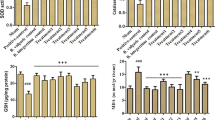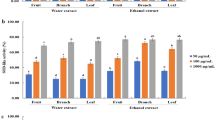Abstract
Pouteria campechiana (Kunth) Baehni. is used as a remedy for coronary trouble, liver disorders, epilepsy, skin disease, and ulcer. Therefore, the present study aims to investigate the antioxidant and hepatoprotective effect of polyphenolic-rich P. campechiana fruit extract against acetaminophen-intoxicated rats. Total phenolic and flavonoid contents of egg fruit were estimated followed by the determination of antioxidant activities. Treatment with P. campechiana fruit extract effectively scavenged the free radicals in a concentration-dependent manner within the range of the given concentrations in all antioxidant models. The presence of polyphenolic compounds were confirmed by high-performance thin-layer chromatography (HPTLC). The animals were treated with acetaminophen (250 mg/kg body weight; p.o.) thrice at the interval of every 5 days after the administration of P. campechiana aqueous extract and silymarin (50 mg/kg). Acetaminophen treatment was found to trigger an oxidative stress in liver, leading to an increase of serum marker enzymes. However, treatment with P. campechiana fruit extract significantly reduced the elevated liver marker enzymes (aspartate transaminase, alanine transaminase, and alkaline phosphatase) and increased the antioxidant enzymes (viz., superoxide dismutase and catalase) and glutathione indicating the effect of the extract in restoring the normal functional ability of hepatocytes. These results strongly suggest that P. campechiana fruit extract has strong antioxidant and significant hepatoprotective effect against acetaminophen-induced hepatotoxicity.






Similar content being viewed by others
References
Abo Salem OM, Abd-Ellah MF, Ghonaim MM (2011) Hepatoprotective activity of quercetin against acrylonitrile-induced hepatotoxicity in rats. J Biochem Mol Toxicol 25(6):386–392
Aebi H (1983) Catalase in vitro. Methods in enzymatic analysis, vol. 3. Academic, New York, pp. 276–286
Balerdi CF, Shaw PE (1998) Sapodilla, sapote and related fruit. In: Shaw PE, Chan HT, Jr., Nagy, S (eds) Tropical and subtropical fruits. AgScience, Inc., Auburndale, FL, pp. 8–136
Bhattacharjee S (2005) Reactive oxygen species and oxidative burst: Roles in stress senescence and signal transduction in plants. Curr Sci 88(9):1113–1121
Bhattacharya HSC, Zhang Wang YJ (2005) Embryonic development of the rosy barb Puntius conchonius Hamilton 1822 (Cyprinidae). Trop Zool 18:25–37
Chan KW, Khong NMH, Iqbal S, Umar IM, Ismail M (2012) Antioxidant property enhancement of sweet potato flour under simulated gastrointestinal pH. Int J Mol Sci 13(7):8987–8997
Eesha BR, Amberkar MV, Kumari MK, Babu S, Vijay M, Lalit M, Rajput R (2011) Hepatoprotective activity of Terminalia paniculata against paracetamol induced hepatocellular damage in Wistar albino rats. Asian Pac J Trop Med 4(6):466–469
Farghaly HS, Hussein MA (2010) Protective effect of curcumin against paracetamol-induced liver damage. Aust J Basic Appl Sci 4(9):4266–4274
Girish C, Pradhan SC (2012) Hepatoprotective activities of picroliv, curcumin, and ellagic acid compared to silymarin on carbon-tetrachloride-induced liver toxicity in mice. J Pharmacol Pharmacother 3(2):149–155
Green LC, Wagner DA, Glogowski J et al (1982) Analysis of nitrate, nitrite and nitrate in biological fluids. Anal Biochem 126:131–138
Gulcin I, Bursal E, Sehitoglu MH, Bilsel M, Goren AC (2010) Polyphenol contents and antioxidant activity of lyophilized aqueous extract of propolis from Erzurum, Turkey. Food Chem Toxicol 48:2227–2238
Halliwell B (1997) Antioxidants and human disease: a general introduction. Nutr Rev 55:44–49
He M, Zhang S, Jiao Y, Lin X, Huang J, Chen C, Chen Z, Huang R (2012) Effects and mechanisms of rifampin on hepatotoxicity of acetaminophen in mice. Food Chem Toxicol 50:3142–3149
Oz HS, McClain CJ, Nagasawa HT, Ray MB, de Villiers WJ, Chen TS (2004) Diverse antioxidants protect against acetaminophen hepatotoxicity. J Biochem Mol Toxic 18(6):361–368
James P, Mayeux PR, Hinson JA (2003) Acetaminophen-induced hepatotoxicity. Drug Metab Dispos 31(12):1499–1506
Jeyadevi R, Sivasudha T, Rameshkumar A, Harnly JM, Lin LZ (2013) Phenolic profiling by UPLC-MS/MS and hepatoprotective activity of Cardiospermum helicacabum against acetaminophen induced liver injury in Wistar rats. Journal Funct Foods 5:289–298
Johnkennedy N, Adamma E (2011) The protective role of Gongronema latifolium in acetaminophen induced hepatic toxicity in Wistar rats. Asian Pac J Trop Biomed 1:S151–S154
Kakkar P, Das B, Viswanathan PN (1984) A modified spectrophotometric assay of SOD. Indian J Biochem Biophys 21:130–132
Karaman S, Tutem E, Baskan KS, Apak R (2010) Comparison of total antioxidant capacity and phenolic composition of some apple juices with combined HPLC-CUPRAC assay. Food Chem 120:1201–1209
King EJ, Armstrong AR (1980) Calcium, magnesium, phosphorous and phosphatase. In: Varley B, Gowenlock AH, Bell M (eds) Practical clinical biochemistry. Heinemann, London, pp. 850–852
King J (1965) The hydrolases-acid and alkaline phosphatases. In: Van, D (ed), Practical Clinical Enzymology. Nostrand Company Ltd., London, pp. 191–197.
Latha TB, Srikanth A, Kumar EK, Mastan SK, Srinivasa Rao Y, Bhavani B (2009) Comparative hepatoprotective efficacy of kumaryasava and Livfit against carbon tetrachloride induced hepatic damage in rats. Pharmacologyonline 1:1127–1134
Lowry OH, Rosebrough NJ, Farr AL, Randall RJ (1951) Protein measurement with the folin phenol reagent. J BiolChem 193:265
Ma J, Yang H, Basile MJ, Kennelly EJ (2004) Analysis of polyphenolic antioxidants from the fruits of three Pouteria species by selected ion monitoring liquid chromatography-mass spectrometry. J Agric Food Chem 52:5873–5878
Malloy HT, Evelyn KA (1937) The determination of bilirubin with the photometric colorimeter. J Biol Chem 119:481–490
Manokaran S, Jaswanth A, Sengottuvelu S, Nandhakumar J, Duraisamy R, Karthikeyan D (2008) Hepatoprotective activity of Aerva lanata Linn. against paracetamol induced hepatotoxicity in rats. Res J Pharm Tech 1:398–400
McGill MR, Sharpe MR, Williams CD, Taha M, Curry SC, Jaeschke H (2012) The mechanism underlying acetaminophen induced hepatotoxicity in humans and mice involves mitochondrial damage and nuclear DNA fragmentation. J Clin Invest 122(4):1547–1583
Moron MS, Depierre JW, Mannervik B (1979) Levels of glutathione, glutathione reductase and glutathione Stransferase activities in rat lung and liver. Biochim Biophys Acta 582:67–78
Morton J (1987) Canistel. In: Julia, F.M. (ed.) Fruits of warm climates. Purdue University, Miami, pp. 402–405
Olaleye MT, Akinmoladun AC, Ogunboye AA, Akindahunsi AA (2010) Antioxidant activity and hepatoprotective property of leaf extracts of Boerhaavia diffusa Linn against acetaminophen-induced liver damage in rats. Food Chem Toxicol 48:2200–2205
Ordonez AAL, Gomez JD, Vattuone MA, Islamic MI (2006) Antioxidant activities of Sechium edule (Jacq.) swartz extracts. Food Chem 97:452–458
Orhan IE, Senera B, Musharraf SG (2012) Antioxidant and hepatoprotective activity appraisal of four selected Fumaria species and their total phenol and flavonoid quantities. Exp Toxicol Pathol 64:205–209
Oyaizu M (1986) Studies on product of browning reaction prepared from glucose amine. Jpn J Nutr 44:307–315
Parmar SR, Vashrambhai PH, Kalia K (2010) Hepatoprotective activity of some plants extract against paracetamol induced hepatotoxicity in rats. J Herb Med Toxicol 4(2):101–106
Rang HP, Dale MM, Ritter JM, Moore PK (2003) Pharmacology, 5th edn. Bath, Churchill Livingstone
Re R, Pellegrini N, Proteggente A, Pannala A, Yang M, Rice-Evans C (1999) Antioxidant activity applying an improved ABTS radical cation decolorization assay. Free Radic Biol Med 26:1231–1237
Reid AB, Kurten RC, McCullough SS, Brock RW, Hinson JA (2005) Mechanisms of acetaminophen-induced hepatotoxicity: role of oxidative stress and mitochondrial permeability transition in freshly isolated mouse hepatocytes. J Pharm Exp Ther 312(2):509–516
Reitman S, Frankel S (1957) Determination of serum glutamate oxaloacetate and glutamic pyruvic acid transaminases. Amer J Clin Pathol 28:56–63
Sabir SM, Ahmad SD, Hamid A, Khan MQ, Athayde ML, Santos DB, Boligon AA, Rocha JBT (2012) Antioxidant and hepatoprotective activity of ethanolic extract of leaves of Solidago microglossa containing polyphenolic compounds. Food Chem 131:741–747
Sadasivam S, Manickam A (1996) Biochemical methods. New age international (P) Limited, Publishers. New Delhi 8:193–194
Siddhuraju P, Becker K (2007) The antioxidant and free radical scavenging activities of rocessed cowpea (Vigna unguiculata) seed extracts. Food Chem 101:10–19
Sindhu ER, Firdous AP, Preethi KC, Kuttan R (2010) Carotenoid lutein protects rats from paracetamol, carbon tetrachloride and ethanol induced hepatic damage. J Pharm Pharmacol 62(8):1054–1060
Singh RP, Murthy CKN, Jayaprakasha GK (2002) Studies on the antioxidant activity of pomegranate (Punica granatum) peel and seed extracts using in vitro models. J Agri Food Chem 50(1):81–86
Smilin Bell Aseervatham G, Shamna R, Sangeetha B, Sasikumar JM (2012) In vivo antioxidant activity of bark extract of Bixa orellana L. against acetaminophen-induced oxidative stress. Asian Pac J Trop Biomed s700–s705
Teepica PDD, Maheshu V, Vishnupriya M, Sasikumar JM (2012) In vitro antioxidant activity of banana (Musa spp. ABB cv. Pisang Awak). Indian J Biochem Biophys 49:124–129
Yang J, Li Y, Wang F, Wu C (2010) Hepatoprotective effects of apple polyphenols on CCl4 induced acute liver damage in mice. J Agri Food Chem 58:6525–6531
You Y, Yoo S, Yoon HG, Park J, Lee YH, Kim S, Oh KT, Lee J, Cho HY, Jun W (2010) In vitro and in vivo hepatoprotective effects of the aqueous extract from Taraxacum officinale (dandelion) root against alcohol-induced oxidative stress. Food Chem Toxicol 48:1632–1637
Acknowledgments
The authors acknowledge the encouragement by Karpagam University, Coimbatore for providing necessary facilities to carry out this research work. Help in the statistical analysis from Dr. V. Maheshu, Karpagam University is acknowledged. The authors are thankful to the Department of Environmental Biotechnology, Bharathidasan University, Tiruchirappalli, Tamilnadu for supporting this study. The authors are also grateful to Dalmia Research Foundation, Coimbatore, India for the HPTLC analysis.
Author information
Authors and Affiliations
Corresponding author
Rights and permissions
About this article
Cite this article
Aseervatham, G.S.B., Sivasudha, T., Sasikumar, J.M. et al. Antioxidant and hepatoprotective potential of Pouteria campechiana on acetaminophen-induced hepatic toxicity in rats. J Physiol Biochem 70, 1–14 (2014). https://doi.org/10.1007/s13105-013-0274-3
Received:
Accepted:
Published:
Issue Date:
DOI: https://doi.org/10.1007/s13105-013-0274-3




